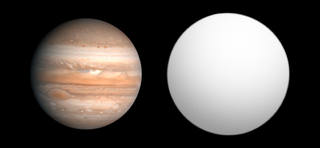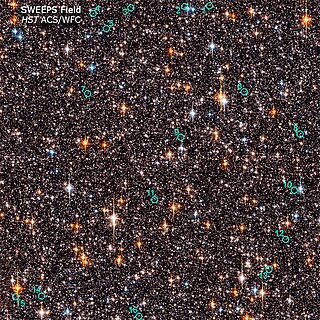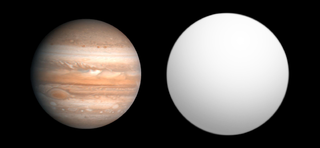
HD 209458 b is an exoplanet that orbits the solar analog HD 209458 in the constellation Pegasus, some 157 light-years from the Solar System. The radius of the planet's orbit is 0.047 AU, or one-eighth the radius of Mercury's orbit. This small radius results in a year that is 3.5 Earth-days long and an estimated surface temperature of about 1,000 °C. Its mass is 220 times that of Earth and its volume is some 2.5 times greater than that of Jupiter. The high mass and volume of HD 209458 b indicate that it is a gas giant.

HD 209458 is a star with an orbiting exoplanet in the constellation Pegasus. It has an apparent visual magnitude of 7.65 and an absolute magnitude of 4.28. Because it is located at a distance of 157 light-years from the Sun as measured via parallax, it is not visible to the unaided eye. With good binoculars or a small telescope it should be easily detectable. The system is drifting closer with a heliocentric radial velocity of −14.8 km/s.

TrES-1b is an extrasolar planet approximately 523 light-years away in the constellation of Lyra. The planet's mass and radius indicate that it is a Jovian planet with a similar bulk composition to Jupiter. Unlike Jupiter, but similar to many other planets detected around other stars, TrES-1 is located very close to its star, and belongs to the class of planets known as hot Jupiters. The planet was discovered orbiting around GSC 02652-01324.
OGLE-TR-111 is a yellow dwarf star approximately 5,000 light-years away in the constellation of Carina. Having an apparent magnitude of about 17, this distant and dim star has not yet been cataloged. Because its apparent brightness changes when one of its planets transits, the star has been given the variable star designation V759 Carinae.

OGLE-TR-10 is a distant, magnitude 16 star in the constellation of Sagittarius. It is located near the Galactic Center. This star is listed as an eclipsing type variable star with the eclipse due to the passage of the planet as noted in the discovery papers.
OGLE-TR-132 is a distant magnitude 15.72 star in the star fields of the constellation Carina. Because of its great distance, about 4,900 light-years, and location in the crowded field it was not notable in any way. Because its apparent brightness changes when one of its planets transits, the star has been given the variable star designation V742 Carinae. The spectral type of the star is type F. A yellow-white, very metal-rich dwarf star, it is slightly hotter and more luminous than the Sun.
HD 38529 is a binary star approximately 138 light-years away in the constellation of Orion.
OGLE-TR-56 is a dim, distant, magnitude 17 Sun-like star located approximately 1,500 parsecs away in the constellation of Sagittarius. This star is listed as an eclipsing type variable star with the eclipse due to the passage of the planet as noted in the discovery papers.

OGLE-TR-56b is an extrasolar planet located approximately 1500 parsecs or 5000 light years away in the constellation of Sagittarius, orbiting the star OGLE-TR-56. This planet was the first known exoplanet to be discovered with the transit method. The object was discovered by the OGLE project, announced on July 5, 2002 and confirmed on January 4, 2003 by the Doppler technique. The period of this confirmed planet was the shortest until the confirmed discovery of WASP-12b on April 1, 2008. The short period and proximity of the OGLE-TR-56 b to its host mean it belongs to a class of objects known as hot Jupiters.

XO-1b is an extrasolar planet approximately 536 light-years away from Earth.

Any planet is an extremely faint light source compared to its parent star. For example, a star like the Sun is about a billion times as bright as the reflected light from any of the planets orbiting it. In addition to the intrinsic difficulty of detecting such a faint light source, the light from the parent star causes a glare that washes it out. For those reasons, very few of the exoplanets reported as of January 2024 have been observed directly, with even fewer being resolved from their host star.

WASP-2b is an extrasolar planet orbiting the star WASP-2 located about 500 light years away in the constellation of Delphinus. It was discovered via the transit method, and then follow up measurements using the radial velocity method confirmed that WASP-2b was a planet. The planet's mass and radius indicate that it is a gas giant with a similar bulk composition to Jupiter. Unlike Jupiter, but similar to many other planets detected around other stars, WASP-2b is located very close to its star, and belongs to the class of planets known as hot Jupiters. A 2008 study concluded that the WASP-2b system is a binary star system allowing even more accurate determination of stellar and planetary parameters.
OGLE-TR-113 is a dim, distant magnitude 16 binary star in the star fields of the constellation Carina. Because of its distance of about 1170 light years, and location in a crowded field it was not notable in any way. Its apparent brightness changes when one of its planets transits, so the star has been given the variable star designation V752 Carinae. Spectral type of the star is type K dwarf star, slightly cooler and less luminous than the Sun.

The Sagittarius Window Eclipsing Extrasolar Planet Search, or SWEEPS, was a 2006 astronomical survey project using the Hubble Space Telescope's Advanced Camera for Surveys - Wide Field Channel to monitor 180,000 stars for seven days to detect extrasolar planets via the transit method.

WASP-11b/HAT-P-10b or WASP-11Ab/HAT-P-10Ab is an extrasolar planet discovered in 2008. The discovery was announced by press release by the SuperWASP project in April 2008 along with planets WASP-6b through to WASP-15b, however at this stage more data was needed to confirm the parameters of the planets and the coordinates were not given. On 26 September 2008, the HATNet Project's paper describing the planet which they designated HAT-P-10b appeared on the arXiv preprint server. The SuperWASP team's paper appeared as a preprint on the Extrasolar Planets Encyclopaedia on the same day, confirming that the two objects were in fact the same, and the teams agreed to use the combined designation.

CoRoT-3b is a brown dwarf or massive extrasolar planet with a mass 21.66 times that of Jupiter. The object orbits an F-type star in the constellation of Aquila. The orbit is circular and takes 4.2568 days to complete. It was discovered by the French-led CoRoT mission which detected the dimming of the parent star's light as CoRoT-3b passes in front of it.

OGLE-TR-113b is an extrasolar planet orbiting the star OGLE-TR-113.

OGLE-TR-111b is an extrasolar planet approximately 5,000 light-years away in the constellation of Carina. The planet is currently the only confirmed planet orbiting the star OGLE-TR-111.

OGLE-TR-132b is an extrasolar planet orbiting the star OGLE-TR-132.

An exoplanet is a planet located outside the Solar System. The first evidence of an exoplanet was noted as early as 1917, but was not recognized as such until 2016; no planet discovery has yet come from that evidence. What turned out to be the first detection of an exoplanet was published among a list of possible candidates in 1988, though not confirmed until 2003. The first confirmed detection came in 1992, with the discovery of terrestrial-mass planets orbiting the pulsar PSR B1257+12. The first confirmation of an exoplanet orbiting a main-sequence star was made in 1995, when a giant planet was found in a four-day orbit around the nearby star 51 Pegasi. Some exoplanets have been imaged directly by telescopes, but the vast majority have been detected through indirect methods, such as the transit method and the radial-velocity method. As of 24 July 2024, there are 7,026 confirmed exoplanets in 4,949 planetary systems, with 1007 systems having more than one planet. This is a list of the most notable discoveries.















